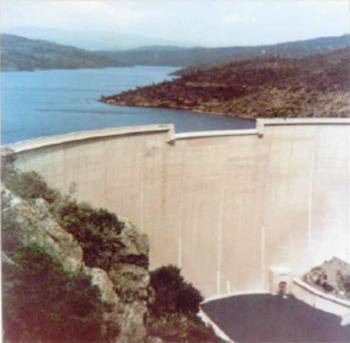Design and Construction of Arch Dams: Difference between revisions
No edit summary |
No edit summary |
||
| Line 12: | Line 12: | ||
==Examples== | ==Examples== | ||
{{Website Icon}} | {{Website Icon}} [https://damfailures.org/case-study/malpasset-dam-france-1959/ Learn from the critical design flaws that led to the failure of Malpasset Dam (DamFailures.org)] | ||
==Best Practices Resources== | ==Best Practices Resources== | ||
{{Document Icon}} [[Arch Dam Design (EM 1110-2-2201)|Arch Dam Design (EM 1110-2-2201) (U.S. Army Corps of Engineers)]] | {{Document Icon}} [[Arch Dam Design (EM 1110-2-2201)|Arch Dam Design (EM 1110-2-2201) (U.S. Army Corps of Engineers)]] | ||
Revision as of 22:37, 28 November 2022

|
| Learn from the critical design flaws that led to the failure of Malpasset Dam (DamFailures.org) |
“Unlike a concrete gravity dam which carries the entire load by its self weight, an arch dam obtains its stability by both the self weight and, to a great extent, by transmitting the imposed loads by arch action into the valley walls. The geometry of the dam site is, therefore, the most basic consideration in the selection of an arch dam. As a general rule, an arch dam requires a site with abutments of sufficient strength to support the arch thrust. On special occasions artificial abutments – thrust blocks – may be used in the absence of suitable abutment(s)”.[1]
Examples
![]() Learn from the critical design flaws that led to the failure of Malpasset Dam (DamFailures.org)
Learn from the critical design flaws that led to the failure of Malpasset Dam (DamFailures.org)
Best Practices Resources
![]() Arch Dam Design (EM 1110-2-2201) (U.S. Army Corps of Engineers)
Arch Dam Design (EM 1110-2-2201) (U.S. Army Corps of Engineers)
![]() Design Criteria for Concrete Arch and Gravity Dams (EM 19) (Bureau of Reclamation)
Design Criteria for Concrete Arch and Gravity Dams (EM 19) (Bureau of Reclamation)
Trainings
![]() On-Demand Webinar: Analysis of Concrete Arch Dams
On-Demand Webinar: Analysis of Concrete Arch Dams
Citations:
Revision ID: 4618
Revision Date: 11/28/2022
